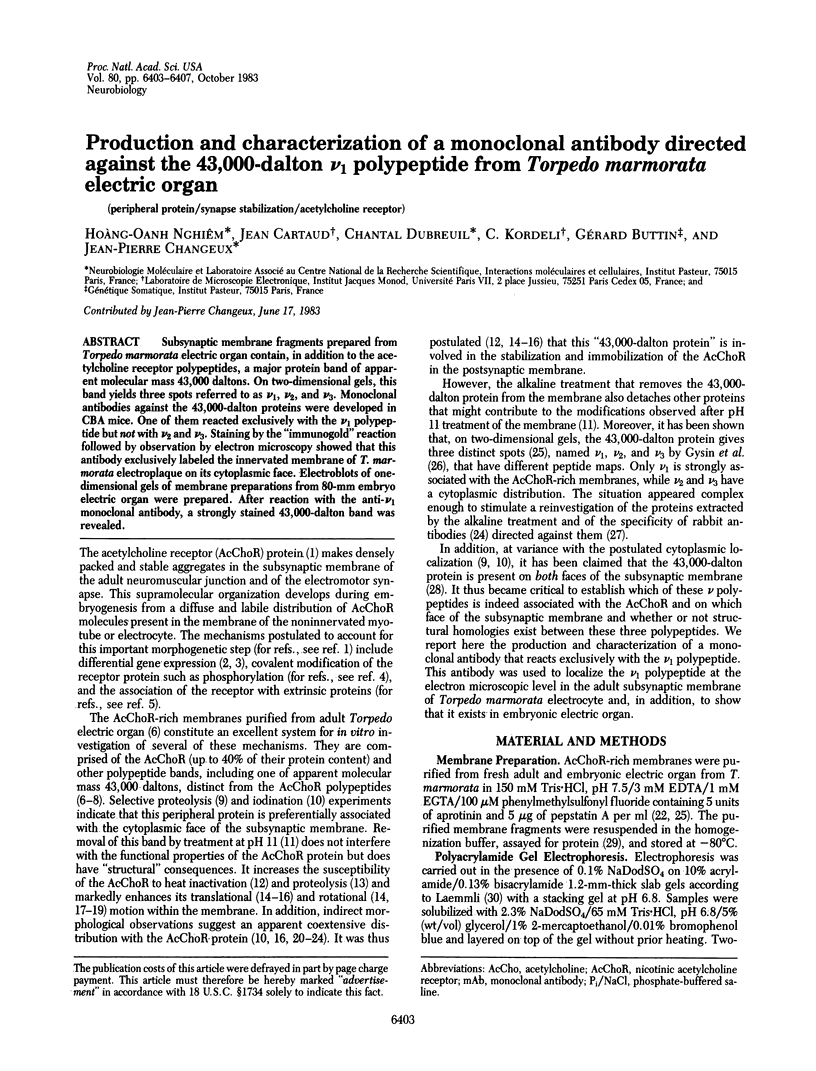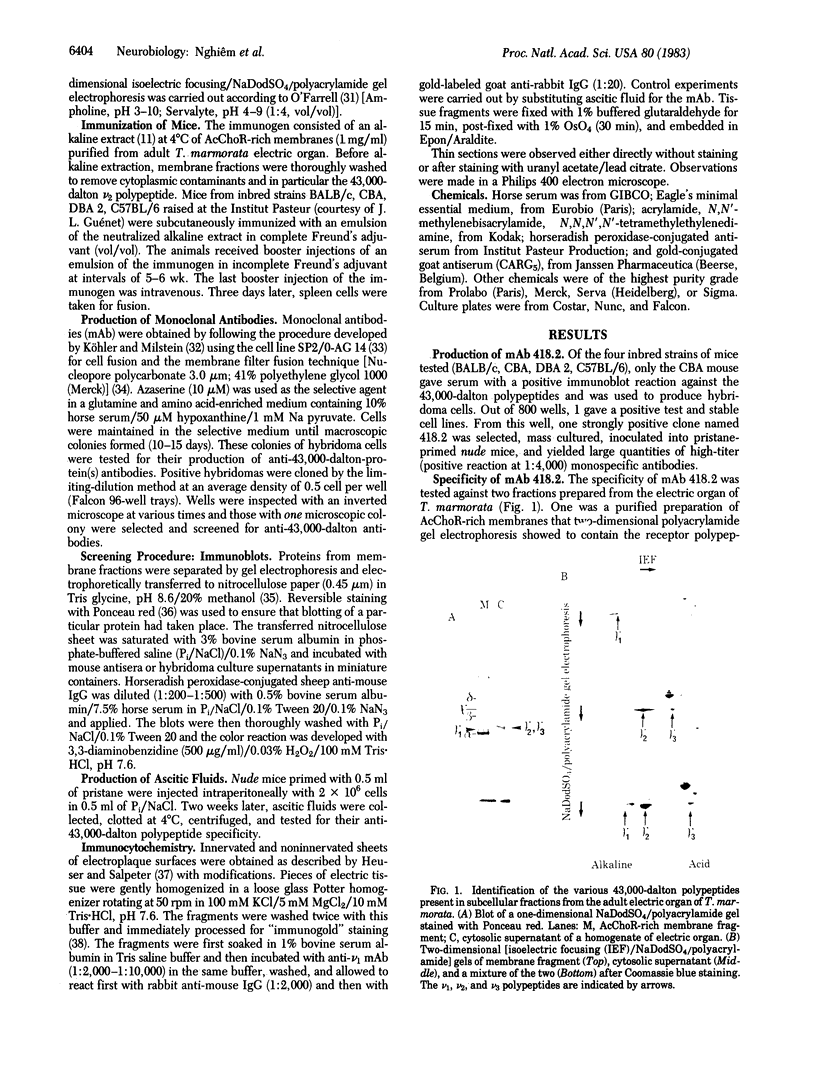Abstract
Subsynaptic membrane fragments prepared from Torpedo marmorata electric organ contain, in addition to the acetylcholine receptor polypeptides, a major protein band of apparent molecular mass 43,000 daltons. On two-dimensional gels, this band yields three spots referred to as v1, v2, and v3. Monoclonal antibodies against the 43,000-dalton proteins were developed in CBA mice. One of them reacted exclusively with the v1 polypeptide but not with v2 and v3. Staining by the "immunogold" reaction followed by observation by electron microscopy showed that this antibody exclusively labeled the innervated membrane of T. marmorata electroplaque on its cytoplasmic face. Electroblots of one-dimensional gels of membrane preparations from 80-mm embryo electric organ were prepared. After reaction with the anti-v1 monoclonal antibody, a strongly stained 43,000-dalton band was revealed.
Full text
PDF




Images in this article
Selected References
These references are in PubMed. This may not be the complete list of references from this article.
- Ballivet M., Patrick J., Lee J., Heinemann S. Molecular cloning of cDNA coding for the gamma subunit of Torpedo acetylcholine receptor. Proc Natl Acad Sci U S A. 1982 Jul;79(14):4466–4470. doi: 10.1073/pnas.79.14.4466. [DOI] [PMC free article] [PubMed] [Google Scholar]
- Barrantes F. J., Neugebauer D. C., Zingsheim H. P. Peptide extraction by alkaline treatment is accompanied by rearrangement of the membrane-bound acetylcholine receptor from Torpedo marmorata. FEBS Lett. 1980 Mar 24;112(1):73–78. doi: 10.1016/0014-5793(80)80131-1. [DOI] [PubMed] [Google Scholar]
- Bartholdi M., Barrantes F. J., Jovin T. M. Rotational molecular dynamics of the membrane-bound acetylcholine receptor revealed by phosphorescence spectroscopy. Eur J Biochem. 1981 Nov;120(2):389–397. doi: 10.1111/j.1432-1033.1981.tb05716.x. [DOI] [PubMed] [Google Scholar]
- Burnette W. N. "Western blotting": electrophoretic transfer of proteins from sodium dodecyl sulfate--polyacrylamide gels to unmodified nitrocellulose and radiographic detection with antibody and radioiodinated protein A. Anal Biochem. 1981 Apr;112(2):195–203. doi: 10.1016/0003-2697(81)90281-5. [DOI] [PubMed] [Google Scholar]
- Cartaud J., Benedetti E. L. A morphological study of the cholinergic receptor protein from Torpedo marmorata in its membrane environment and in its detergent-extracted purified form. J Cell Sci. 1978 Feb;29:313–337. doi: 10.1242/jcs.29.1.313. [DOI] [PubMed] [Google Scholar]
- Cartaud J., Sobel A., Rousselet A., Devaux P. F., Changeux J. P. Consequences of alkaline treatment for the ultrastructure of the acetylcholine-receptor-rich membranes from Torpedo marmorata electric organ. J Cell Biol. 1981 Aug;90(2):418–426. doi: 10.1083/jcb.90.2.418. [DOI] [PMC free article] [PubMed] [Google Scholar]
- Changeux J. P. The acetylcholine receptor: an "allosteric" membrane protein. Harvey Lect. 1979 1980;75:85–254. [PubMed] [Google Scholar]
- Conti-Tronconi B. M., Dunn S. M., Raftery M. A. Functional stability of Torpedo acetylcholine receptor. Effects of protease treatment. Biochemistry. 1982 Mar 2;21(5):893–899. doi: 10.1021/bi00534a013. [DOI] [PubMed] [Google Scholar]
- Fox G. Q., Richardson G. P. The developmental morphology of Torpedo marmorata: electric organ--electrogenic phase. J Comp Neurol. 1979 May 15;185(2):293–315. doi: 10.1002/cne.901850205. [DOI] [PubMed] [Google Scholar]
- Froehner S. C., Gulbrandsen V., Hyman C., Jeng A. Y., Neubig R. R., Cohen J. B. Immunofluorescence localization at the mammalian neuromuscular junction of the Mr 43,000 protein of Torpedo postsynaptic membranes. Proc Natl Acad Sci U S A. 1981 Aug;78(8):5230–5234. doi: 10.1073/pnas.78.8.5230. [DOI] [PMC free article] [PubMed] [Google Scholar]
- Giraudat J., Devillers-Thiery A., Auffray C., Rougeon F., Changeux J. P. Identification of a cDNA clone coding for the acetylcholine binding subunit of Torpedo marmorata acetylcholine receptor. EMBO J. 1982;1(6):713–717. doi: 10.1002/j.1460-2075.1982.tb01235.x. [DOI] [PMC free article] [PubMed] [Google Scholar]
- Gysin R., Wirth M., Flanagan S. D. Structural heterogeneity and subcellular distribution of nicotinic synapse-associated proteins. J Biol Chem. 1981 Nov 25;256(22):11373–11376. [PubMed] [Google Scholar]
- Heuser J. E., Salpeter S. R. Organization of acetylcholine receptors in quick-frozen, deep-etched, and rotary-replicated Torpedo postsynaptic membrane. J Cell Biol. 1979 Jul;82(1):150–173. doi: 10.1083/jcb.82.1.150. [DOI] [PMC free article] [PubMed] [Google Scholar]
- Klymkowsky M. W., Heuser J. E., Stroud R. M. Protease effects on the structure of acetylcholine receptor membranes from Torpedo californica. J Cell Biol. 1980 Jun;85(3):823–838. doi: 10.1083/jcb.85.3.823. [DOI] [PMC free article] [PubMed] [Google Scholar]
- Krenz W. D., Tashiro T., Wächtler K., Whittaker V. P., Witzemann V. Aspects of the chemical embryology of the electromotor system of Torpedo marmorata with special reference to synaptogenesis. Neuroscience. 1980;5(3):617–624. doi: 10.1016/0306-4522(80)90059-7. [DOI] [PubMed] [Google Scholar]
- Köhler G., Milstein C. Continuous cultures of fused cells secreting antibody of predefined specificity. Nature. 1975 Aug 7;256(5517):495–497. doi: 10.1038/256495a0. [DOI] [PubMed] [Google Scholar]
- LOWRY O. H., ROSEBROUGH N. J., FARR A. L., RANDALL R. J. Protein measurement with the Folin phenol reagent. J Biol Chem. 1951 Nov;193(1):265–275. [PubMed] [Google Scholar]
- Laemmli U. K. Cleavage of structural proteins during the assembly of the head of bacteriophage T4. Nature. 1970 Aug 15;227(5259):680–685. doi: 10.1038/227680a0. [DOI] [PubMed] [Google Scholar]
- Lo M. M., Garland P. B., Lamprecht J., Barnard E. A. Rotational mobility of the membrane-bound acetylcholine receptor of Torpedo electric organ measured by phosphorescence depolarisation. FEBS Lett. 1980 Mar 10;111(2):407–412. doi: 10.1016/0014-5793(80)80838-6. [DOI] [PubMed] [Google Scholar]
- Neubig R. R., Krodel E. K., Boyd N. D., Cohen J. B. Acetylcholine and local anesthetic binding to Torpedo nicotinic postsynaptic membranes after removal of nonreceptor peptides. Proc Natl Acad Sci U S A. 1979 Feb;76(2):690–694. doi: 10.1073/pnas.76.2.690. [DOI] [PMC free article] [PubMed] [Google Scholar]
- O'Farrell P. H. High resolution two-dimensional electrophoresis of proteins. J Biol Chem. 1975 May 25;250(10):4007–4021. [PMC free article] [PubMed] [Google Scholar]
- Rousselet A., Cartaud J., Devaux P. F., Changeux J. P. The rotational diffusion of the acetylcholine receptor in Torpeda marmorata membrane fragments studied with a spin-labelled alpha-toxin: importance of the 43 000 protein(s). EMBO J. 1982;1(4):439–445. doi: 10.1002/j.1460-2075.1982.tb01188.x. [DOI] [PMC free article] [PubMed] [Google Scholar]
- Rousselet A., Cartaud J., Devaux P. F. Effects of temperature, lipid modification and pH on the mobility of the major proteins of the receptor-rich membranes from Torpedo marmarata. Biochim Biophys Acta. 1981 Nov 6;648(2):169–185. doi: 10.1016/0005-2736(81)90032-8. [DOI] [PubMed] [Google Scholar]
- Rousselet A., Cartaud J., Devaux P. F. Importance des interactions protéine-protéine dans les maintien de la structure des fragments excitables de l'organe électrique de Torpedo marmorata. C R Seances Acad Sci D. 1979 Sep 24;289(5):461–463. [PubMed] [Google Scholar]
- Saitoh T., Changeux J. P. Change in state of phosphorylation of acetylcholine receptor during maturation of the electromotor synapse in Torpedo marmorata electric organ. Proc Natl Acad Sci U S A. 1981 Jul;78(7):4430–4434. doi: 10.1073/pnas.78.7.4430. [DOI] [PMC free article] [PubMed] [Google Scholar]
- Saitoh T., Changeux J. P. Phosphorylation in vitro of membrane fragments from Torpedo marmorata electric organ. Effect on membrane solubilization by detergents. Eur J Biochem. 1980 Mar;105(1):51–62. doi: 10.1111/j.1432-1033.1980.tb04473.x. [DOI] [PubMed] [Google Scholar]
- Saitoh T., Wennogle L. P., Changeux J. P. Factors regulating the susceptibility of the acetylcholine receptor protein to heat inactivation. FEBS Lett. 1979 Dec 15;108(2):489–494. doi: 10.1016/0014-5793(79)80595-5. [DOI] [PubMed] [Google Scholar]
- Sealock R. Cytoplasmic surface structure in postsynaptic membranes from electric tissue visualized by tannic-acid-mediated negative contrasting. J Cell Biol. 1982 Feb;92(2):514–522. doi: 10.1083/jcb.92.2.514. [DOI] [PMC free article] [PubMed] [Google Scholar]
- Sealock R., Kavookjian A. Postsynaptic distribution of acetylcholine receptors in electroplax of the torpedine ray, Narcine brasiliensis. Brain Res. 1980 May 19;190(1):81–93. doi: 10.1016/0006-8993(80)91161-0. [DOI] [PubMed] [Google Scholar]
- Shulman M., Wilde C. D., Köhler G. A better cell line for making hybridomas secreting specific antibodies. Nature. 1978 Nov 16;276(5685):269–270. doi: 10.1038/276269a0. [DOI] [PubMed] [Google Scholar]
- Sobel A., Heidmann T., Cartaud J., Changeux J. P. Reconstitution of a functional acetylcholine receptor. Polypeptide chains, ultrastructure, and binding sites for acetylcholine and local anesthetics. Eur J Biochem. 1980 Sep;110(1):13–33. doi: 10.1111/j.1432-1033.1980.tb04838.x. [DOI] [PubMed] [Google Scholar]
- Sobel A., Heidmann T., Hofler J., Changeux J. P. Distinct protein components from Torpedo marmorata membranes carry the acetylcholine receptor site and the binding site for local anesthetics and histrionicotoxin. Proc Natl Acad Sci U S A. 1978 Jan;75(1):510–514. doi: 10.1073/pnas.75.1.510. [DOI] [PMC free article] [PubMed] [Google Scholar]
- Sobel A., Weber M., Changeux J. P. Large-scale purification of the acetylcholine-receptor protein in its membrane-bound and detergent-extracted forms from Torpedo marmorata electric organ. Eur J Biochem. 1977 Oct 17;80(1):215–224. doi: 10.1111/j.1432-1033.1977.tb11874.x. [DOI] [PubMed] [Google Scholar]
- St John P. A., Froehner S. C., Goodenough D. A., Cohen J. B. Nicotinic postsynaptic membranes from Torpedo: sidedness, permeability to macromolecules, and topography of major polypeptides. J Cell Biol. 1982 Feb;92(2):333–342. doi: 10.1083/jcb.92.2.333. [DOI] [PMC free article] [PubMed] [Google Scholar]
- Strader C. D., Lazarides E., Raftery M. A. The characterization of actin associated with postsynaptic membranes from Torpedo californica. Biochem Biophys Res Commun. 1980 Jan 29;92(2):365–373. doi: 10.1016/0006-291x(80)90342-3. [DOI] [PubMed] [Google Scholar]
- Towbin H., Staehelin T., Gordon J. Electrophoretic transfer of proteins from polyacrylamide gels to nitrocellulose sheets: procedure and some applications. Proc Natl Acad Sci U S A. 1979 Sep;76(9):4350–4354. doi: 10.1073/pnas.76.9.4350. [DOI] [PMC free article] [PubMed] [Google Scholar]
- Wennogle L. P., Changeux J. P. Transmembrane orientation of proteins present in acetylcholine receptor-rich membranes from Torpedo marmorata studied by selective proteolysis. Eur J Biochem. 1980 May;106(2):381–393. doi: 10.1111/j.1432-1033.1980.tb04584.x. [DOI] [PubMed] [Google Scholar]
- Witzemann V., Richardson G., Boustead C. Characterization and distribution of acetylcholine receptors and acetylcholinesterase during electric organ development in Torpedo marmorata. Neuroscience. 1983;8(2):333–349. doi: 10.1016/0306-4522(83)90070-2. [DOI] [PubMed] [Google Scholar]












